Dumbbells and free weights are hardy pieces of kit, but that doesn’t mean they don’t need some TLC once in a while. Learning how to look after your dumbbells can be the difference between one that breaks within a year and one that lasts a lifetime. This post explains how to clean and maintain dumbbells, using PowerBlock and Bowflex as two examples.
Most types of dumbbells can be cleaned using a soap water solution and microfibre towel. Simply wipe the dumbbell using the wet cloth and pat dry. However, rusty metal dumbbells should be treated with a rust-removing solution that can be homemade or store-bought.
Having owned a collection of dumbbells over the years, I’ve also had to learn how to look after them.
Below, I’ll share my research and experience in how to do so!

- Why Dumbbells Should Be Washed And Cleaned
- Best Ways To Clean Dumbbells And Weights
- How To Clean Dirty Dumbbells
- How To Clean A Dumbbell Using Mild Soap And Warm Water
- How To Deep Clean A Rusty Metal Dumbbell
- Why New Dumbbells Are Sometimes Smelly And Greasy
- Tips To Maintain And Care For Dumbbells
- How To Clean PowerBlock Dumbbells
- Tips To Maintain PowerBlocks
- How To Clean Bowflex Dumbbells
- Tips To Maintain Bowflex Dumbbells
- Conclusion
Why Dumbbells Should Be Washed And Cleaned
All types of dumbbells can and should be washed regularly. Frequently cleaning a dumbbell using DIY methods will remove the build-up of dirt, bacterial growth, and rust. As a result, this can improve dumbbell function, performance, hygiene, and overall lifetime.
Look.
Weight equipment, including dumbbells, generally need very little maintenance.
In fact, a lot of people don’t bother at all.
But learning how to look after your dumbbell can make the difference between one that goes into the trash and one that lasts you forever.
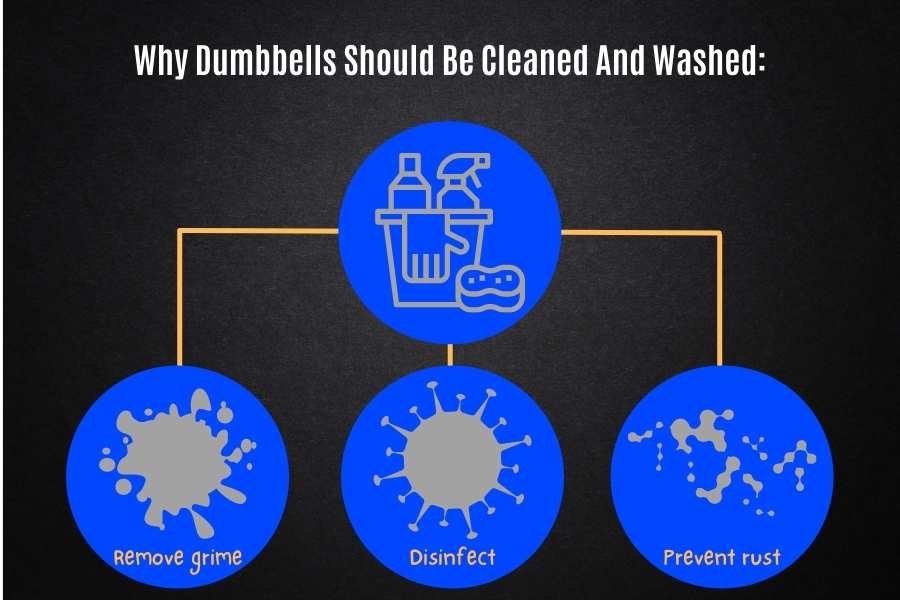
Here’s why dumbbells should be washed on frequently:
- Removes dirt build-up. Dust, grime, and oil can accumulate in the nooks and crannies of a dumbbell. This can cake on over time and affect dumbbell function (especially on adjustable dumbbells with moving components).
- Removes bacterial growth. Bacteria is transferred onto a dumbbell every time you touch it. And these little critters feast on any sweat that gets onto the dumbbell. This creates an unpleaseant BO-like smell and is not very hygienic.
- Removes rust. Cleaning your dumbbells every now and then can remove rust and prevent it from spreading and getting worse.
It doesn’t matter if your dumbbells are cheap Amazon Basics or expensive PowerBlocks/Bowflex, the cleaning procedure is generally similar for all the different types of dumbbells.
Best Ways To Clean Dumbbells And Weights
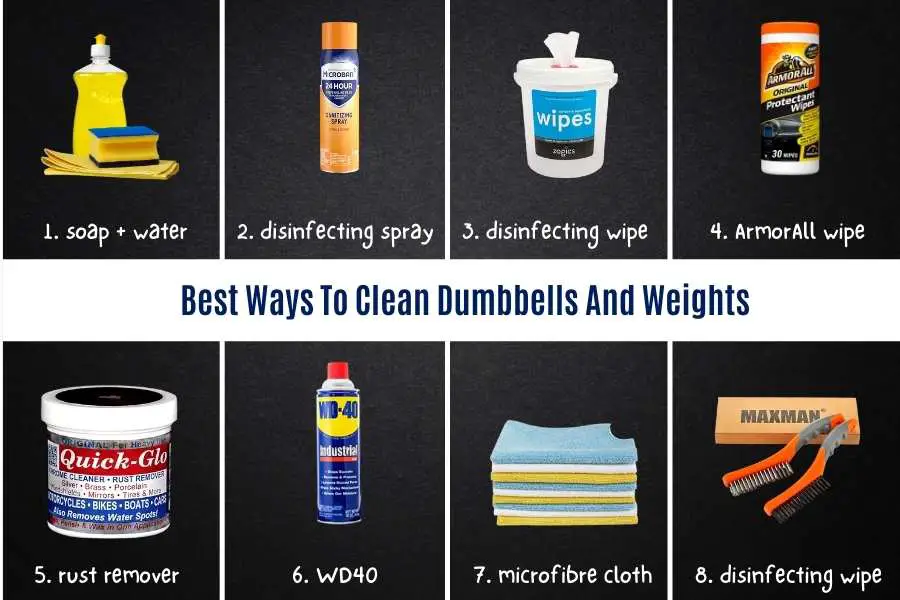
Here are the best solutions and equipment to clean a dumbbell and weights in general:
- Mild soap and warm water. Most dumbbells can be cleaned using a mild detergent and warm water solution. Simply mix a few drops of detergent in a 1/4 gallon of water. This is enough to remove dirt and oil from the dumbbell without leaving behind a greasy film.
- Disinfectant spray. Dumbbells can be quickly cleaned using a disinfectant aerosol or liquid spray. This is a convenient way to sterilize a dumbbell, remove bacteria, and eliminate unpleasant odors. I recommend the EPA-certified Microban spray.
- Disinfectant wipes. Same as above. Wipes can be more suitable than sprays in small rooms where ventilation is inadequate. I recommend the Zogic wipes.
- ArmorAll wipes. ArmorAll makes automobile interior wipes but these double up as excellent wipes for rubber dumbbells. They remove grease, oil, and dirt from the dumbbell surface. But they can also restore discolored rubber and protect the outer layer from UV rays. However, they are not the best for disinfecting dumbbell.
- Rust removers. Rust-removing solutions are the best way to treat a rusted and corroded metal dumbbell. Solutions can be easily made at home using common acids and alkalis such as vinegar and baking soda. Ready-made solutions can also be bought from a store. I recommend this Quick Glo rust remover.
- WD40 lubricating spray. WD40 can be used on all weights, including dumbbells, to clean and protect the equipment. This is done by applying a thin coat onto the equipment and wiping it dry. This displaces water, lubricates the weight, and also helps prevent rust from forming.
- Microfibre towel. These have soft fibers that won’t scratch your dumbbell. A good microfibre like these Amazon basics towels is also lint-free meaning it won’t leave an irritating fluff all over your dumbbell plates.
- Steel or brass brush. The rigid bristles are great for removing caked on dirt and rust from metal dumbbells. Avoid using these on rubber, neoprene, and vinyl plastic dumbbells because they’ll become scratched. This Maxman steel brush has a thin profile which is ideal for reaching all the nooks and crannies in a dumbbell.
How To Clean Dirty Dumbbells
In most cases, you can get away with a simple soap and water wash or disinfectant wipe/spray.
But in other cases, a more specialized method should be used since different types of dumbbells are made with different materials and outer layers.
Here’s an overview of how to clean dumbbells according to their material and condition:
How To Clean A Dumbbell Using Mild Soap And Warm Water
This is a general method that can be used to clean all types of dumbbells:
- Prepare the soap and water solution. A few drops of dishwashing detergent or hand soap per 1/4 gallon of warm water should be strong enough to remove most forms of dirt.
- Soak a micofibre cloth in the soap solution. You want the cloth to be saturated in the cleaning solution.
- Wring out the excess water. Squeeze out excess water from the cloth. It should be wet but not drenched.
- Wipe the dumbbell. Apply some elbow grease to clean all the dirty areas. Re-soak the cloth to keep it warm and steaming. This can help lift dirt and oil.
- Use a new microfibre cloth to dry the dumbbell. Pat down the dumbbell using a new microfibre cloth.
- Allow to air dry. Leave outside or in a well-ventilated area for any remaining moisture to dry out.
How To Deep Clean A Rusty Metal Dumbbell
This method is for deep cleaning a metal dumbbell that has succumbed to rust, corrosion, and caked dirt:
- Wipe down the dumbbell to remove loose debris. Use a microfibre cloth or kitchen towel. Your goal is to remove loose dirt for now, not to scrub it clean. So a quick job will do.
- Scrub the dumbbell using a metal brush and water. You don’t need to apply too much pressure yet. Brush the dumbbell lightly but rapidly in a circular motion to continue removing loose surface dirt.
- Prepare an acid soak solution. Mix a soaking solution of 1 part water with 1 part mild acid (white vinegar and lemon is the cheapest but any acidic solution works). E.g. 1L water + 1L vinegar in a 2L bucket.
- Soak the dumbbell for 24 hours. Fully submerge the dumbbell in the acid solution and leave it to soak for 24-48 hours.
- Prepare an alkali paste. Mix 3 parts baking soda with 1 part water to create a paste. E.g. 300g baking soda + 100ml water.
- Apply alkali paste to the dumbbell. Remove the dumbbell from the acid soaking solution and apply the alkali paste to quickly neutralize the acid and prevent flash rusting. Coat the entire dumbbell in the paste making sure the rusted areas are liberally covered. Let it sit for an hour.
- Scrub with a metal brush. Apply some elbow grease here. That’s the only way to make sure all the rust is removed. You can repeat the soaking process to weaken stubborn rust spots and caked dirt.
- Rinse with hot water. This is essential. You don’t want any acid or alkali left on your dumbbell. This can corrode the metal over time and weaken your dumbbell.
- Dry with a microfibre towel. Again, this is essential. The metal is currently in a vulnerable state. You don’t want water to sit on the metallic surface and start rusting again. Get in all the nooks and crannies. Use a kitchen towel afterward if you need to.
- Apply a layer of WD40 spray. This removes any remaining water and keeps the dumbbell water-repellant. Don’t spray it directly onto the dumbbell. Instead, spray on a microfibre cloth and rub it in. Then buff it off with a clean microfibre.
Disclaimer: This method is designed for stainless steel and iron dumbbells. It can strip paint and damage vinyl/rubber/neoprene (so this should be avoided). These types of dumbbells should be cleaned with the water and soap method described previously.
Why New Dumbbells Are Sometimes Smelly And Greasy
New dumbbells can be oily, greasy, and emit a chemical smell. This usually happens with rubber dumbbells for two reasons. Firstly, factories apply oil to protect rubber during storage and this can make a dumbbell greasy. Secondly, oils in rubber can oxidize in the air which causes it to smell.
So it all comes down to the manufacturing process AND the natural properties of rubber.
Luckily, there are ways to remove the oil and smell from dumbbells:
- Clean with soap and warm water. See the previous section above.
- Do not use harsh solvents. This is generally good practice when cleaning and maintaining your dumbbells. Strong chemicals can damage the rubber and weaken the dumbbell.
- Sit the dumbbell in a well-ventilated room. This can remove some of the odor which can be especially intense straight out of the box.
- Place the dumbbell in direct sunlight. UV rays and heat will break down the oils and odor. Leaving rubber dumbbells in direct sunlight for a few hours won’t weaken the integrity of the dumbbell.
These are good ways to clean and maintain dumbbells straight out of their factory packaging.
Tips To Maintain And Care For Dumbbells
So you’ve cleaned your dumbbells, now you should implement steps to maintain them properly.
This prevents deterioration and reduces the likelihood of needing to deep clean them again in the future.
It’s important to maintain your dumbbells properly; otherwise, metals can rust, rubber and neoprene can split, and moving parts can become jammed.
Here are some tips on how to maintain dumbbells properly take care of them to make sure they last you for years:
- Wipe down after every workout. No detergent is necessary. A simple wet microfibre towel will do. This prevents smells and odors developing on your dumbbells.
- Disinfect the handle at least once every 3 months. Spray with a disinfectant aerorsol or use wipes. This prevents bacterial build-up occuring in the handle knurling which can make you ill and make the dumbbell smell foul.
- Deep clean dumbbells when necessary. Use a stiff brush and/or warm soapy water to remove oil, dirt, and debris from your dumbbells (use a sponge for rubber/neoprene/vinyl dumbbells).
- Clean dumbbells with detergent once a month. This is general good practice when it comes to maintaining your dumbbells.
- Do not drop dumbbells. Most dumbbells are durable but that doesn’t mean they should be abused. Adjustable dumbbells in particular should not be dropped. Moving parts will break and warranties will be voided.
- Buy a high-quality dumbbell. Good brands include but aren’t limited to; York, Rogue, REP, PowerBlock, Bowflex, Yes4All, and Core Home Fitness. These dumbbells are generally more durable, the moving parts are less likely to degrade, and they are less prone to wear and tear. You can check out my other article if you’re struggling to decide between PowerBlock or Bowflex.
- Keep your dumbbells dry. Most dumbbells can tolerate water without being damaged. However, it is not advised to keep them wet for extended periods of time. Water can leak into the internal mechanisms of adjustable dumbbells or promote the formation of rust in metal dumbbells.
- Store dumbbells inside. Most dumbbells can be stored outside on a temporary basis. However, it is not recommended to keep them outside for prolonged periods of time. Humidity and extreme temperature changes can cause the dumbbell to rust and degrade very quickly. They should be kept inside instead.
- Keep dumbbells away from prolonged sunlight. Strong UV rays can discolour and degrade the plastics and rubbers found in a lot of dumbbells. This is especially troublesome on adjustable dumbbells which often feature plastic moving parts in their adjustment mechanisms.
- Keep dumbbells away from sharp objects. This will maintain your dumbbell’s rubber components. Sharp objects can scratch and cause a rubber dumbbell to eventually crack.
- Avoid cleaning dumbbells with harsh chemicals. This includes alcohol, ammonia, bleach, strong acids, phenols, and acetone. Do not use these chemicals if you want to maintain the integrity of your dumbbells.
- Fix broken dumbbells and loose parts immediately. A good way to maintain your dumbbells is to make visual inspections once in while. Replace damaged parts immediately. This is usually covered by a manufacturer’s limited warranty period.
- Remove rust as soon as possible. It’s essential to clean rust from dumbbells ASAP. Use the steps described previously in this article.
Next, I’ll show you how to clean and maintain dumbbells using PowerBlocks and Bowflex as examples.
How To Clean PowerBlock Dumbbells
PowerBlocks can be cleaned like all dumbbells by using warm water and soap. This solution can be made by adding a few drops of mild detergent into a quarter gallon of warm water. A microfibre cloth can then be used to scrub the dumbbell clean and pat it dry.
Here’s what this looks like with the PowerBlock Elites:
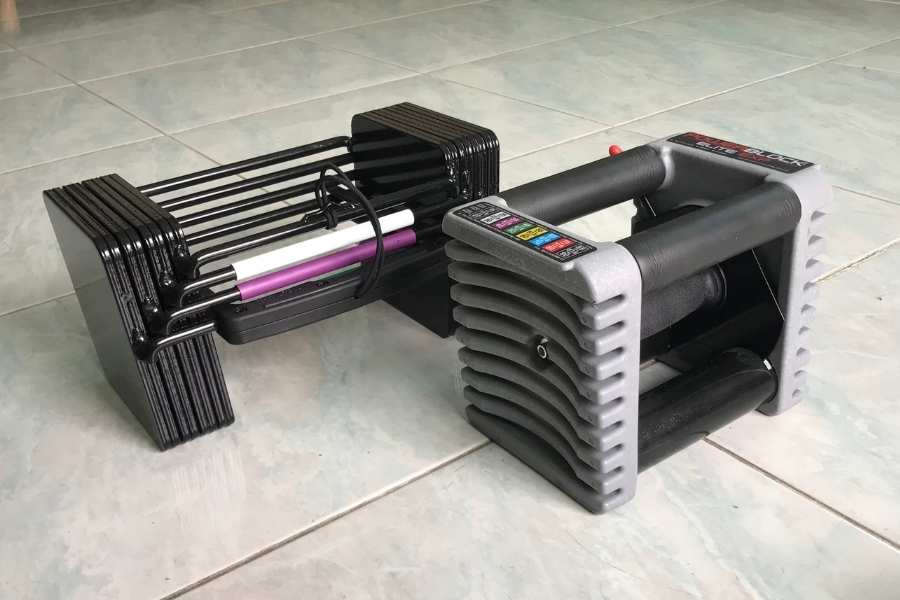
- Disassemble the weight plate and handle. This is done by pulling the selector pin out and pulling the handle away from the main weight nest.
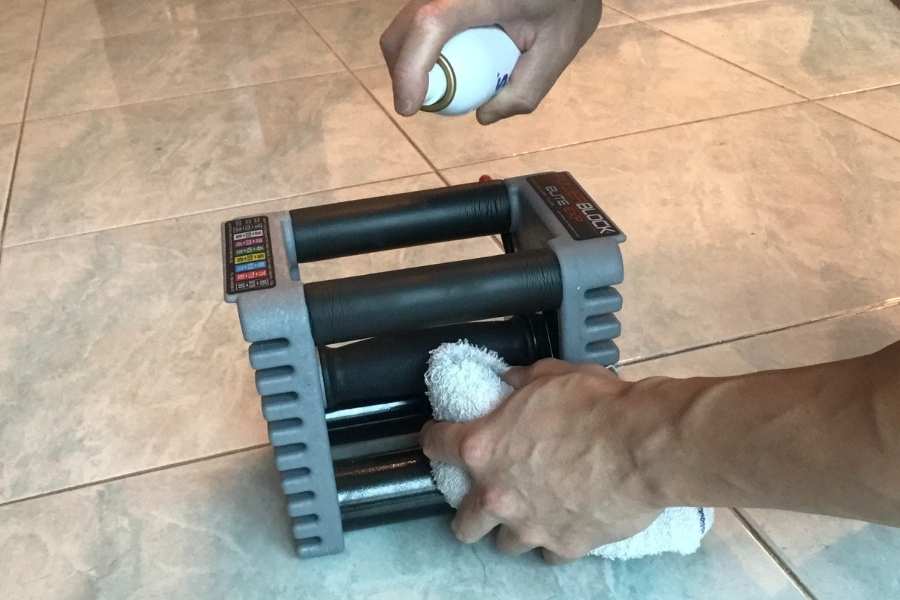
- Wipe handle with disinfectant. I prefer an aerosol spray to get into all the small gaps, but an antibacterial wipe works too.
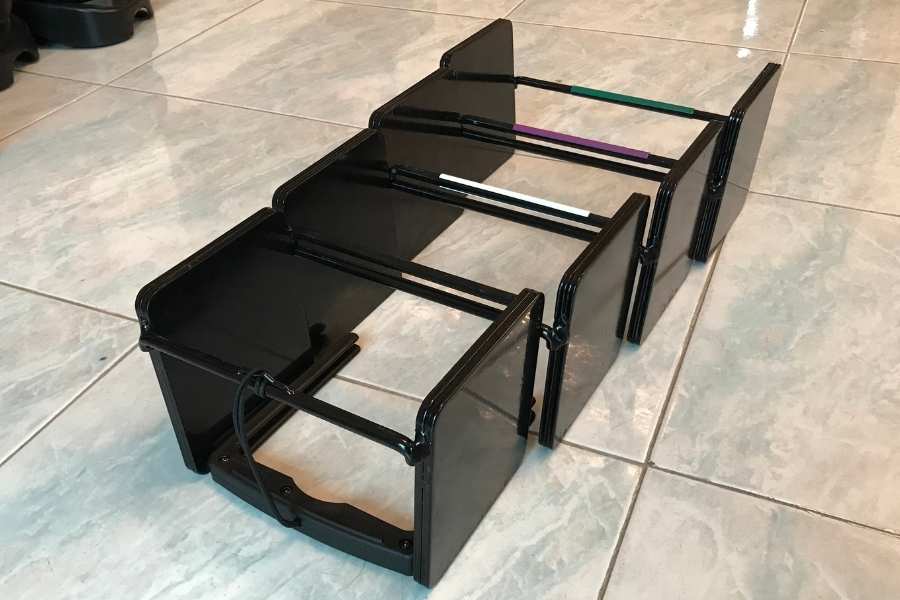
- Detach each weight plate. Simply pull each plate out of the weight nest.
- Remove rust from weight plates if necessary. Follow instructions given previously in this post.

- Prepare a warm water and soap solution. Soak a microfibre cloth in this cleaning mix.
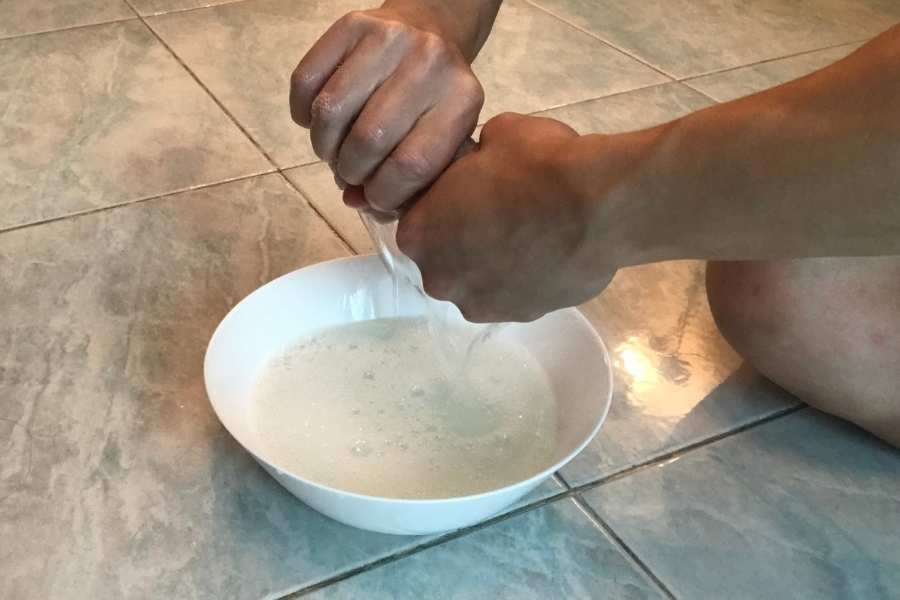
- Wring the cloth dry. It should be damp but not drenched and dripping with liquid.
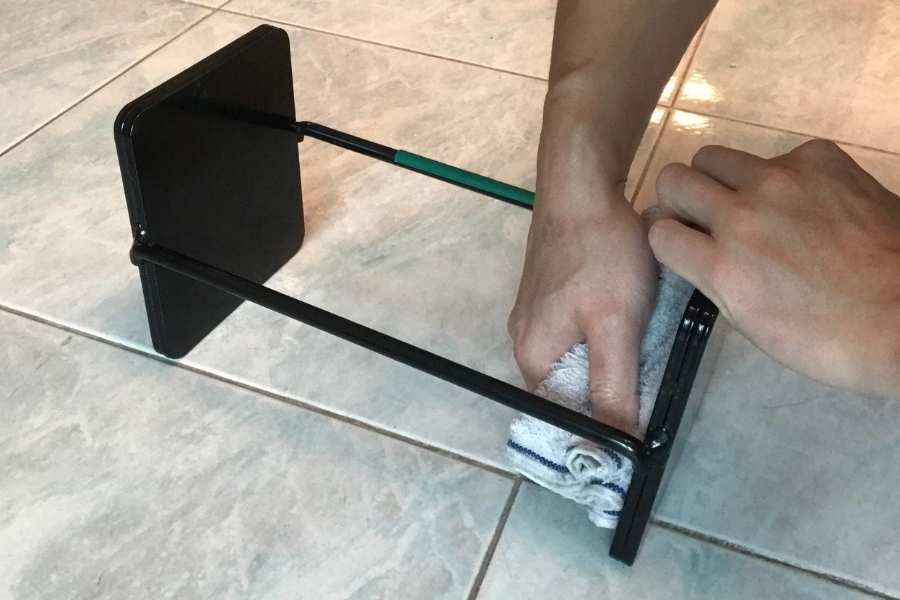
- Wipe weight plates with a cleaning solution. Scrub hard to remove stubborn areas of dirt.
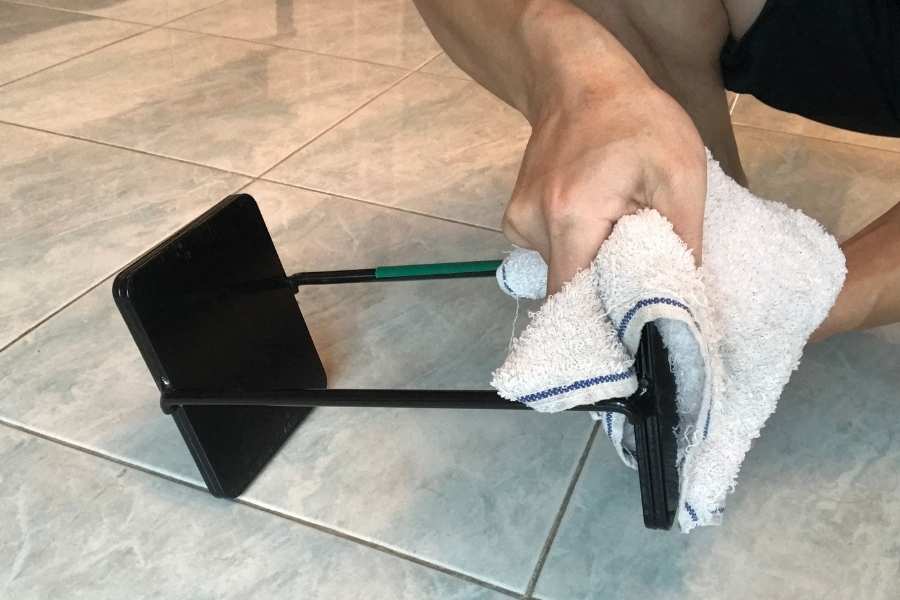
- Pat dry with a clean microfibre cloth. You can also use kitchen towel. PowerBlock also recomend wiping their dumbbells using Armorall wipes to help restore discolored trimmings and urethane plates (where applicable).
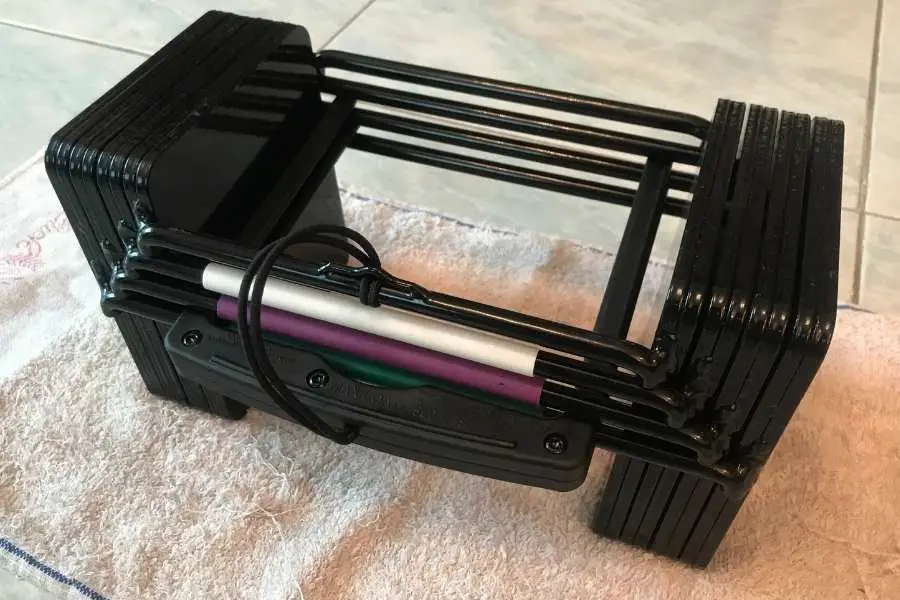
- Allow to air dry. This will take around 30-60 minutes to dry completely (depending on ambient temperature).
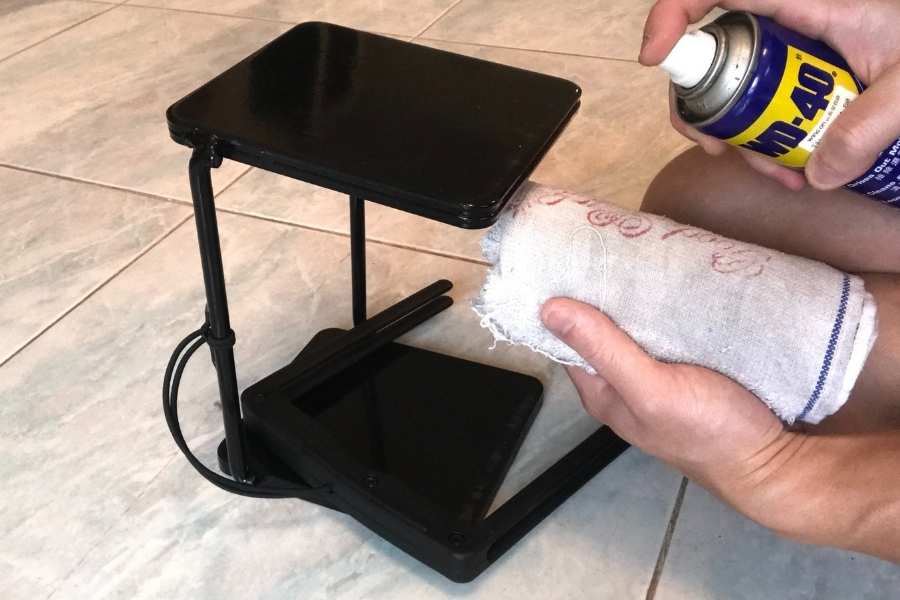
- Apply a coat of WD40. Spray onto a clean microfibre cloth and rub onto the weight plates. Buff off with another microfibre cloth.
There you have it!
That’s how to clean your PowerBlock dumbbells!
If you’re interested in getting these awesome dumbbells, you can check out my full PowerBlock Elite EXP review here!
Tips To Maintain PowerBlocks
PowerBlocks can be looked after and maintained just like any other dumbbell. They should not be dropped, not be allowed to strike each other during workouts, be cleaned regularly, rust removed, and the auto-lock switch lubricated. This ensures optimal dumbbell function.
Here’s how to maintain the PowerBlock dumbbells in detail:
- Do not drop them. PowerBlocks are durable dumbbells, but that doesn’t mean they should be abused! The PowerBlock warranty won’t cover damage as a result of drops greater than 12″.
- Do not allow the dumbbells to strike each other. For example, don’t bash them together at the top of a chest fly. This can scratch the dumbbell and damage the pin.
- Inspect the dumbbell prior to use. This is advised in the instruction manual. Loose parts and worn components should be fixed by contacting PowerBlock for replacement parts.
- Make sure the tether cord is intact. This connects the pin to the main unit. It prevents the selector pin from falling off.
- Maintain rust-free weight plates. As per instructions earlier in this post. Re-apply metal paint if necessary.
- Use WD40 to protect chipped paint. Otherwise, the metal underneath could begin rusting.
- Lubricate the auto-lock switch. This can be done once a year to keep it running smoothly.
And that’s how you maintain your PowerBlock dumbbells!
If you’re interested in the PowerBlocks, you can find out how long and how much they cost to ship here!
How To Clean Bowflex Dumbbells
Bowflex dumbells can be cleaned just like any other free weight by using warm water and detergent. This is made by adding a few drops of hand soap to a quarter gallon of warm water. A microfibre cloth can then be used to scrub and pat the dumbbell dry.
Here’s what this looks like with the Bowflex SelectTech 552:
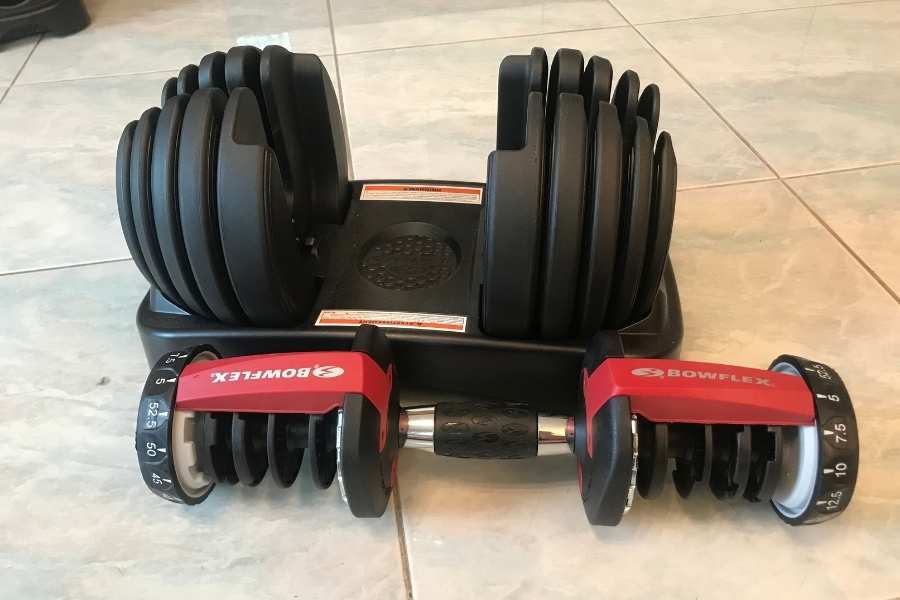
- Disassemble the handle from the weight plates. This is done by selecting the 5lb setting on both dials and pulling the handle from the main weight nest.
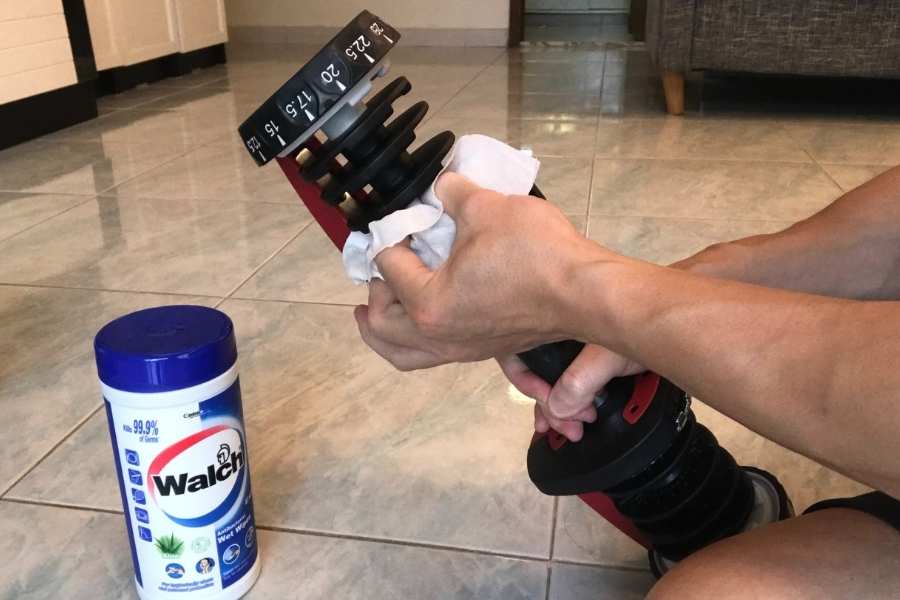
- Wipe the handle with disinfectant. You can use an aerosol spray or anti-bacterial wipes. Wipes are more convenient and work well on the Bowflex 552 handle because all areas are accessible.
- Remove rust if necessary. Most of the Bowfex 552 components are covered in plastic. But the chrome-plated handle could rust over time.
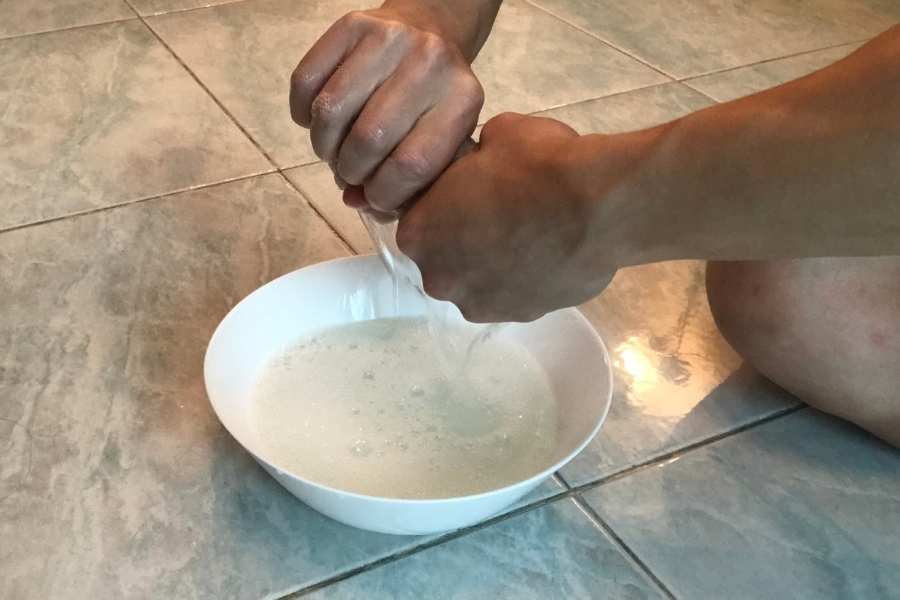
- Soak a clean microfibre towel in a soap water cleaning solution. Wring it dry. The towel should be damp but not drenched.
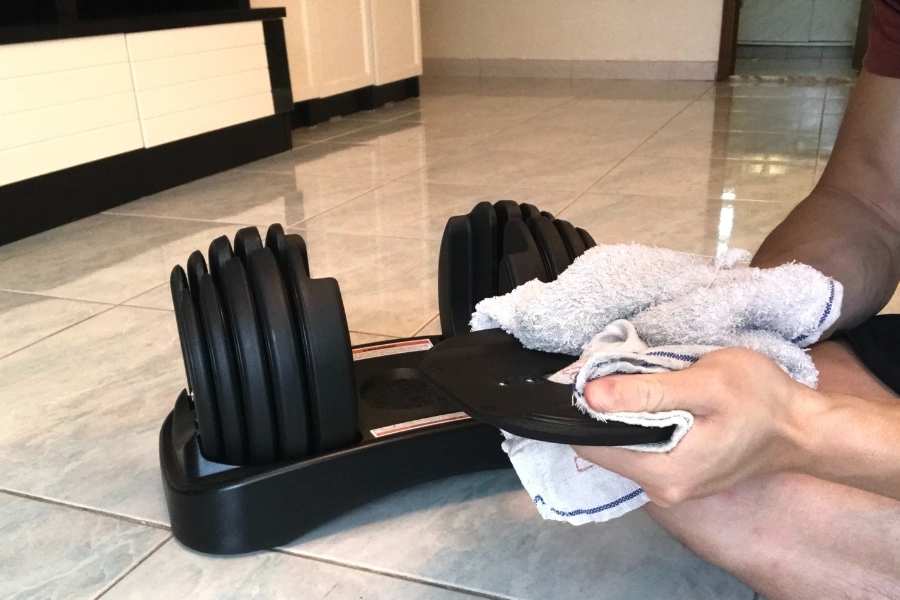
- Wipe the weight plates using the microfibre. Each plate can be separately taken out the Bowflex cradle and cleaned. Wipe down with a clean microfibre cloth. This how Bowflex recommend cleaning the dumbbells in their manual.
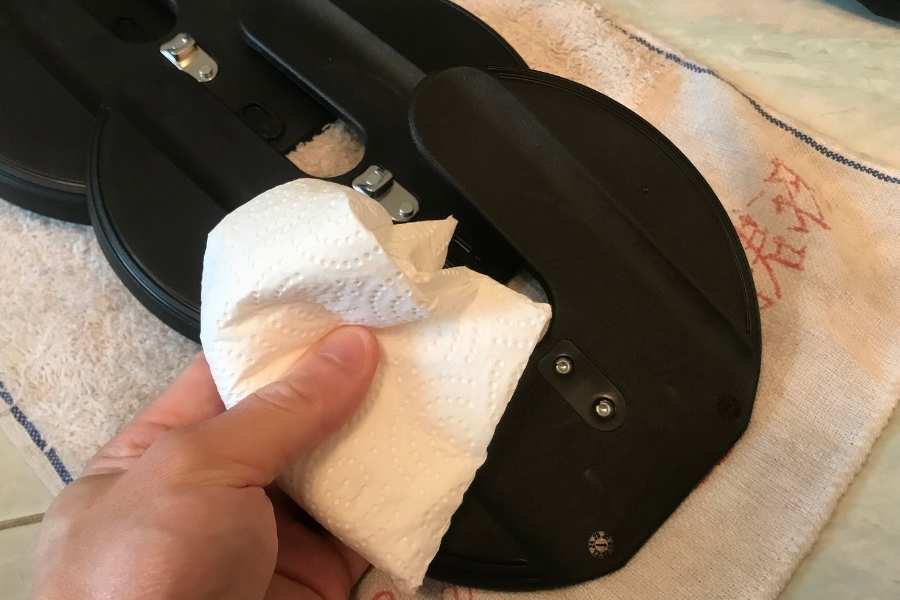
- Pat the plates dry using kitchen towel. This speeds the drying process.
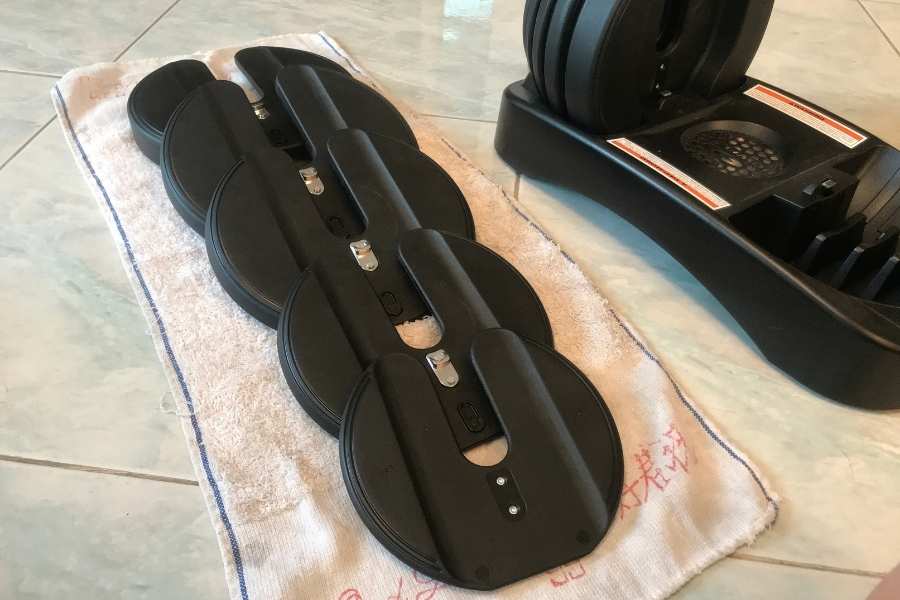
- Allow the plates to air dry. This shouldn’t take more than 30 minutes since all surfaces are exposed to air (there aren’t many crevices).
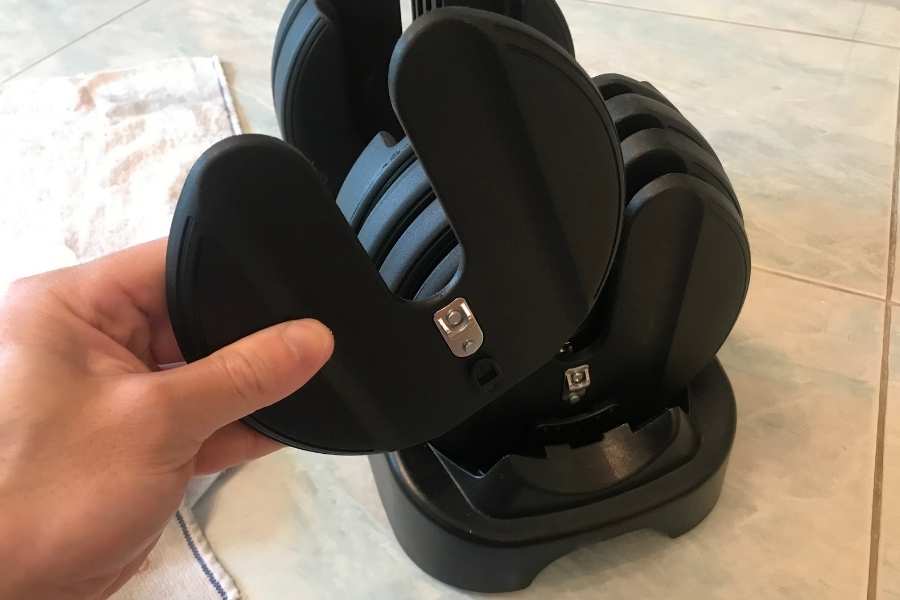
- Reinsert the weight plates back into the cradle. Simply slide them in making sure the metal notch on each weight plate is facing the outside.
And that’s how you clean the Bowflex dumbbells!
If you’re interested in getting these dumbbells, you can check out my full Bowflex 552 review here!
Tips To Maintain Bowflex Dumbbells
Bowflex dumbbells can be looked after and maintained just like any other dumbbell. They should not be dropped, not be allowed to hit each other during workouts, be cleaned regularly, and have the dial switch lubricated if necessary. This ensures optimal dumbbell function.
Here’s how to maintain the Bowflex dumbbells in detail:
- Do not drop your Bowflex dumbbells. This is directly advised by Bowflex themselves. There are warning messages on both the dumbbell as well as the cradle.
- Do not lean on the Bowflex dumbbells. They cannot be used for exercises like the dumbbell push-up or renegade row.
- Lubricate sparingly. The Bowflex adjustment mechanism is already designed to be low friction. Only apply a few drops of WD40 if essential. Lubricating oil should be applied directly into the internal locking discs and weight adjustment dial.
- Do not use harsh solvents. This dumbbell is mostly made from plastic which can degrade if treated with solvents. Stick with the warm water and soap method.
- Visually inspect the internal locking discs. Make sure they aren’t cracked or damaged.
- Correctly insert the dumbbell into the base. It should be dropped in vertically and not at an angle.
For more details, you can check out my other post on Bowflex durability and maintenance.
Conclusion
I’ve explained how to clean and maintain dumbbells, using PowerBlock and Bowflex as two examples.
A simple soap and water solution are adequate to clean most types of dumbbells (including metal, rubber, neoprene, vinyl, painted, and adjustable dumbbells.).
But if you have rusty metal dumbbells, you’ll need to treat them with a rust-removing solution (homemade or store-bought).
Additionally, you should follow the good maintenance practices detailed in this post to keep your dumbbells working optimally!
Are there any other ways to clean and maintain dumbbells you can think of?
Feel free to send me a message if you have any questions! You can find my details on the “contact us” page.
You may also be interested in the downloadable Kalibre Blueprint PDF which details exactly how I gained 40lbs of lean muscle (it’s 100% free!). It details the exact exercises and nutrition (with printable worksheets) I used to go from skinny to ripped!
Thanks for reading guys!
Peace Out,
Kal
(Biochemistry BSc, Biomedical Sciences MSc, Ex-Skinny Guy)


